Alabama boasts a diverse array of wildlife, including deer, foxes, armadillos, and so much more. Venture down to its coastal areas, and you can encounter numerous types of fish as well as marine mammals such as whales. The “Heart of Dixie” is also home to many critters that creep and crawl. Case in point, there are many species of spider commonly found throughout Alabama. While most are harmless, the state also harbors several venomous spiders. Here are 10 different spiders in Alabama that you can expect to discover if you ever travel or live there.
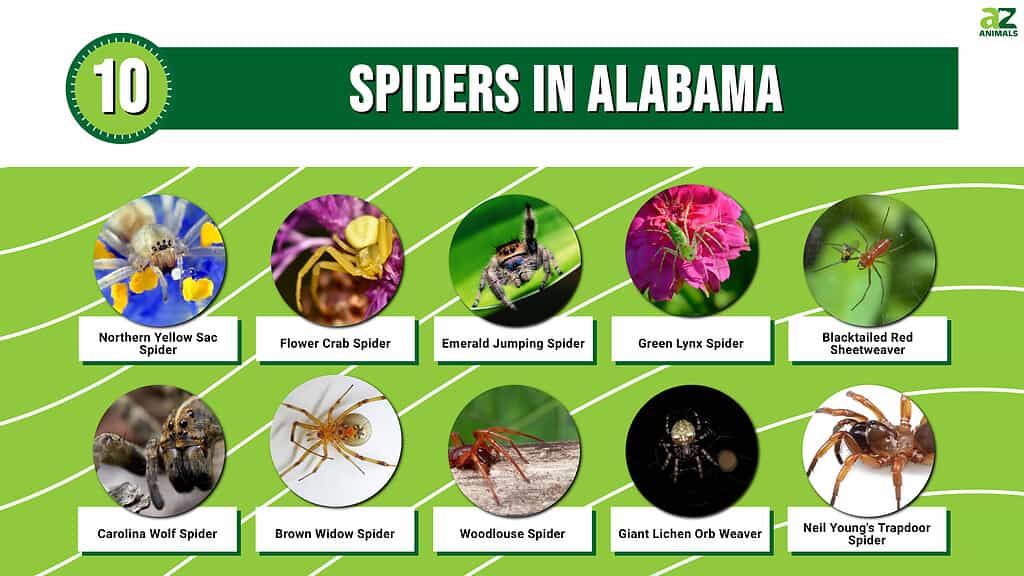
Read on to learn more about these ten spiders including appearance, size, and more!
#10: Neil Young’s Trapdoor Spider
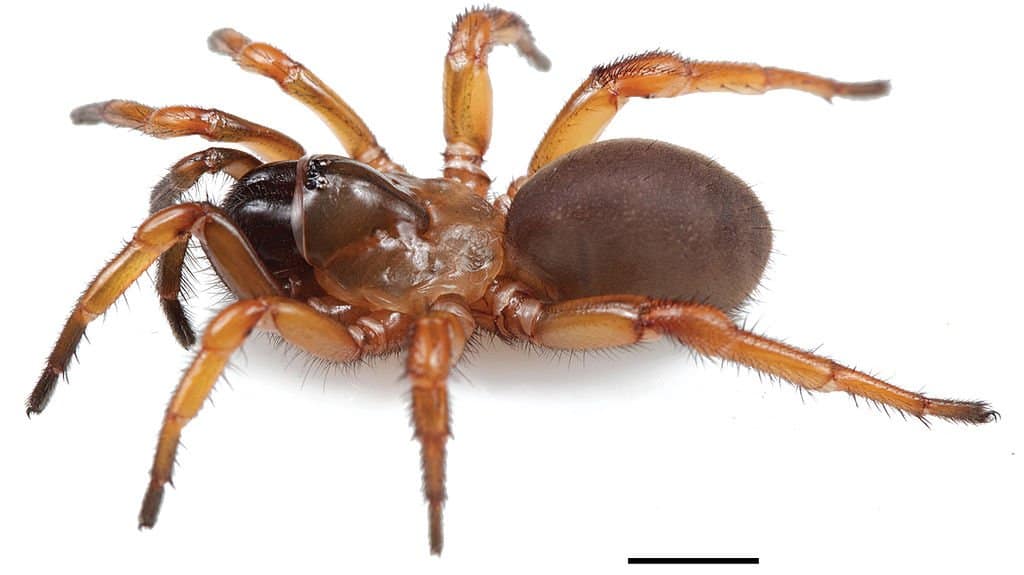
Neil Young’s trapdoor spider is named after the famous American musician Neil Young.
©Jason E. Bond / Creative Commons – License
First described in 2007, Neil Young’s trapdoor spider is named after American rock musician Neil Young. A species of trapdoor spider, Neil Young’s trapdoor spider builds a burrow which it uses to hide from predators and also to ambush prey. It camouflages its burrow with a trapdoor made from silk and then leaps out to snag prey that passes by unawares. Rather than relying on eyesight, the spider detects prey by sensing vibrations through the ground.
While you can find these spiders in Alabama, Neil Young’s trapdoor spider is also present in parts of Florida. In appearance, the spider is light to dark brown, with orangish-brown legs. It is an average size trapdoor spider, measuring from 2.4 to 4 centimeters long. Like other trapdoor spiders, it boasts six eyes instead of the normal eight eyes on most other spider species.
#9: Giant Lichen Orb Weaver
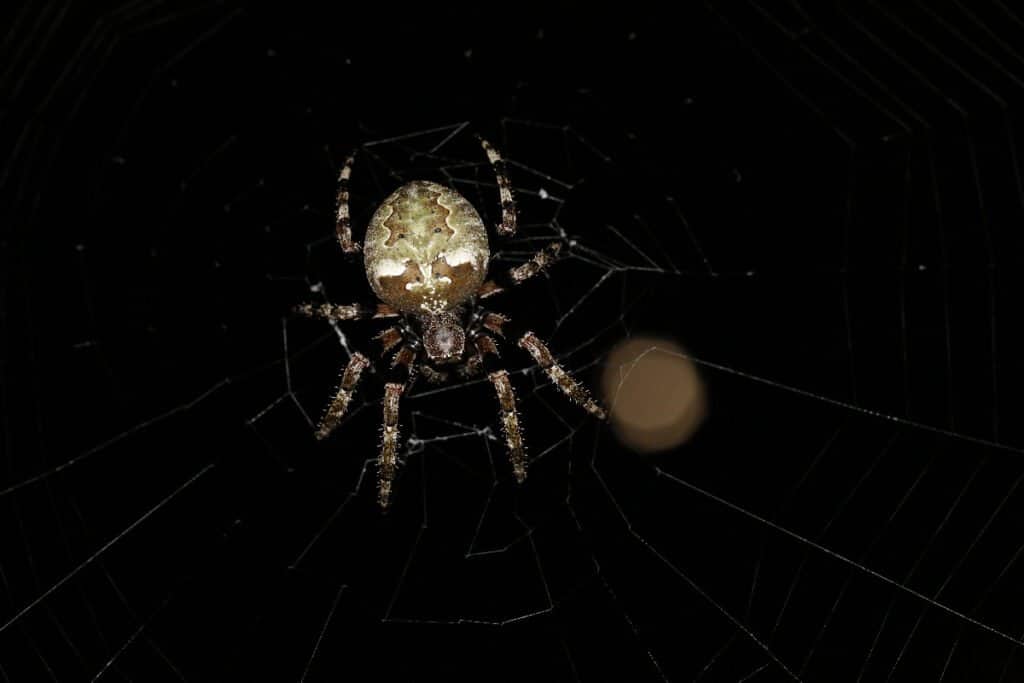
The giant lichen orb weaver creates webs nearly 8 feet wide.
©Cathleen Wake Gorbatenko/Shutterstock.com
The giant lichen orb weaver earns its name from the impressive webs they create, which can measure nearly 8 feet in diameter. It’s also one of the heaviest orb weaver species, as it sports a massive abdomen, further adding evidence to its deserved name.
Most giant lichen orb weavers measure around 2.4 centimeters long in terms of body size. They typically feature orange legs with black rings and a greyish-green body with black and white markings. Due to their similar color, it is sometimes confused with the European garden spider, which is distinguishable due to its cross-shaped markings.
Giant lichen orb weavers are mostly active at night, so you’ll rarely encounter one of these spiders during the day. Even if you do run into one, its bite is relatively harmless. Most people compare it to a bee sting, causing pain and some redness or swelling.
#8: Woodlouse Spider

The woodlouse spider gets its name from its habit of preying on woodlice, also known as pillbugs.
©K Hanley CHDPhoto/Shutterstock.com
Originally from Mediterranean Europe, the woodlouse spider is another one of the common spiders in Alabama. It gets its name not from its appearance but from its habit of preying upon woodlice. Due to this practice, it also goes by the name pillbug hunter or sowbug killer.
Female woodlouse spiders have bodies that measure around 11 to 15 millimeters. Meanwhile, males measure around 9 to 10 millimeters long. Unlike most spiders, they possess 6 eyes instead of 8, and also abnormally large chelicerae. Their bodies and legs appear orangish-red, although their abdomen is more of a yellowish-brown color.
You’ll normally encounter woodlouse spiders under logs or bricks, in woodpiles, or anywhere else where woodlice frequent. They hunt at night and spend their days in specially constructed burrows which they cover in silk. While their bite is powerful, capable of piercing through a pillbug’s hard shell, it is relatively harmless to humans.
#7: Brown Widow

The brown widow sports a similar hourglass-marking as its cousin, the black widow.
©Decha Thapanya/Shutterstock.com
The brown widow is a subtropical spider originally thought to have evolved in Africa. That said, you can now find it throughout the Gulf Coasts states, including Alabama.
Unlike the more recognizable black widow spider, the brown widow sports brown and tan coloration with black markings, hence its name. However, like its cousin the black widow, the brown widow does sport an hourglass-shaped marking on its body. Females have a body length measuring between 7 and 10 millimeters, while males measure around 2 to 4 millimeters.
Compared to a black widow, the bite from a brown widow is not as dangerous. This likely has to do with the fact that a brown widow doesn’t deliver as much toxin per bite. Still, brown widows are poisonous and possess neurotoxins that can prove dangerous to humans Overall, though, a bite from a brown widow is likely to only cause some mild pain, redness, and swelling to the affected area.
#6: Carolina Wolf Spider
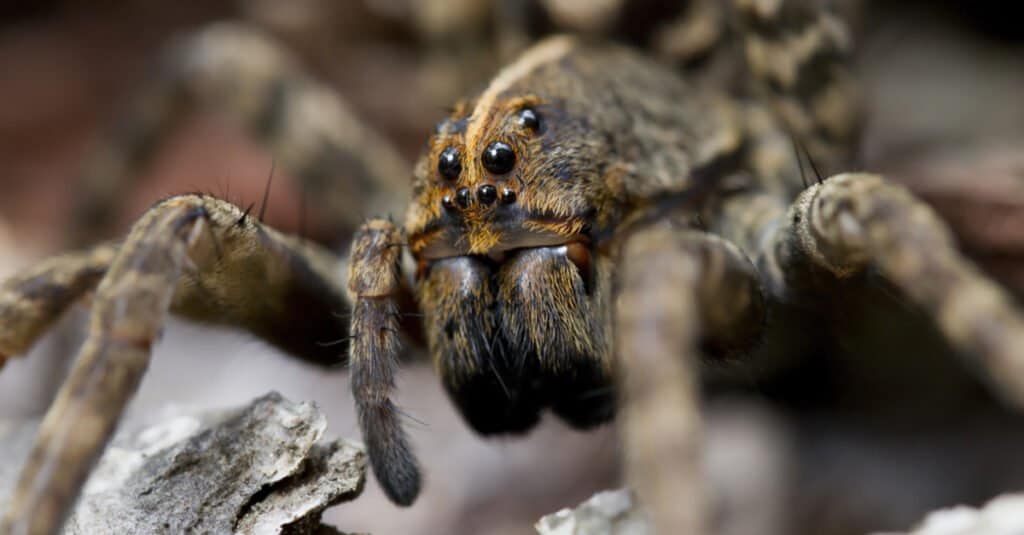
The Carolina wolf spider is the largest wolf spider found in North America.
©Will E. Davis/Shutterstock.com
The Carolina wolf spider is a member of the family Lycosidae, which comes from the Ancient Greek word for wolf. While named after the Carolinas, these wolf spiders are found throughout North America, including Alabama.
It is the largest wolf spider in North America, with females measuring between 22 and 35 millimeters, and males measuring 18 to 20 millimeters. Most specimens are predominantly a light brown color with darker brown markings. If you encounter one at night, you may notice its reflective eyes, which is one of its most identifiable characteristics. Additionally, females are distinguishable by their habit of carrying their egg sacs on their spinnerets.
Unlike most other spiders, Carolina wolf spiders hunt do not spin webs. Instead, they hunt by creating burrows from which they spring out and ambush prey. Despite their large size, their bite is relatively harmless to humans.
#5: Blacktailed Red Sheetweaver

The blacktailed red sheetweaver is a dwarf spider that weaves a flat, tight web.
©Robert Webster / xpda.com / CC-BY-SA-4.0 – License
Also known as the red grass spider, the blacktailed red sheetweaver is a dwarf spider in the family Linyphiidae. Most adult specimens measure only 3 to 4 millimeters long, with females measuring a bit bigger than males.
So far, the blacktailed red sheetweaver is only known to live in Mexico, the United States, and the West Indies. You’re likely to find the spiders in Alabama grasslands, fields, or even in backyards.
It’s named for its distinctive bright red color, black caudal tubercule, and habit of weaving flat, tight webs. The blacktailed red sheetweaver’s flat web is made of non-sticky silk, above which is suspended a tangle of intercepting threads. Prey that that become tangled in the threads fall into the tight web and are then attacked by the spider.
#4. Green Lynx Spider
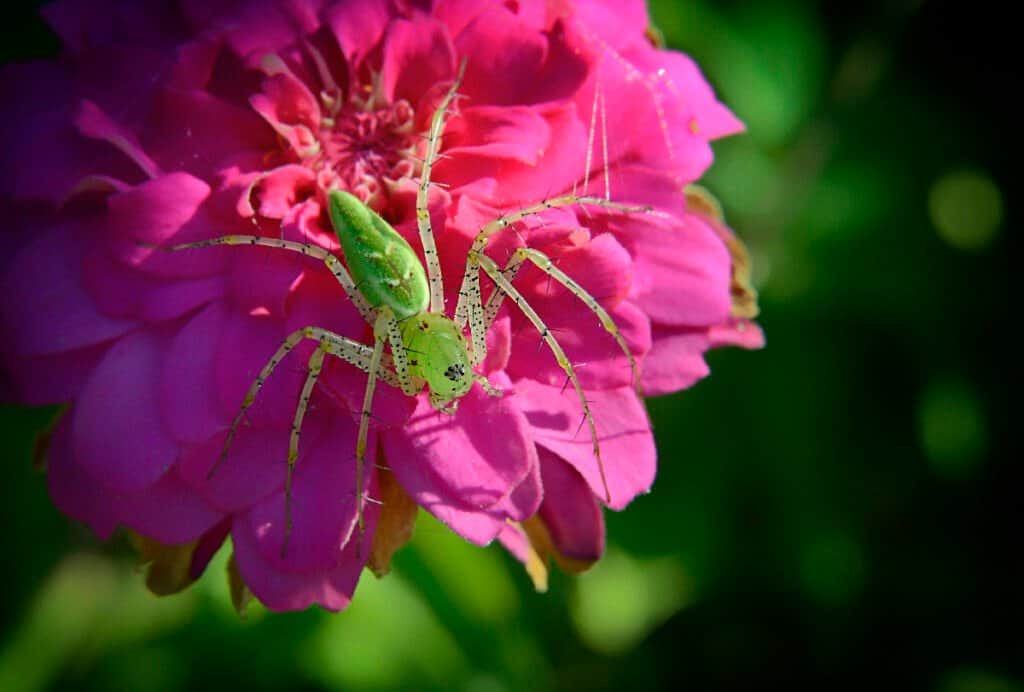
The green lynx spider is the largest species of lynx spider in North America.
©iStock.com/Lois_McCleary
The green lynx spider is the largest species of lynx spider found in Alabama and North America at large. Females measure anywhere from 12 to 22 millimeters in length, while males measure slightly smaller. Its body is bright green with red markings and its legs appear yellowish-green.
Green lynx spiders feed on several insects that target commercial crops and act as a form of natural pest control. At the same time, they also prey on beneficial insects such as honey bees. As such, pest control with the use of green lynx spiders must be carefully conducted to ensure that the spiders do not cause more damage than they mitigate.
While they can act quite aggressively toward their prey, they rarely bite humans. Their bite causes little more than mild pain and some redness or swelling.
#3. Emerald Jumping Spider
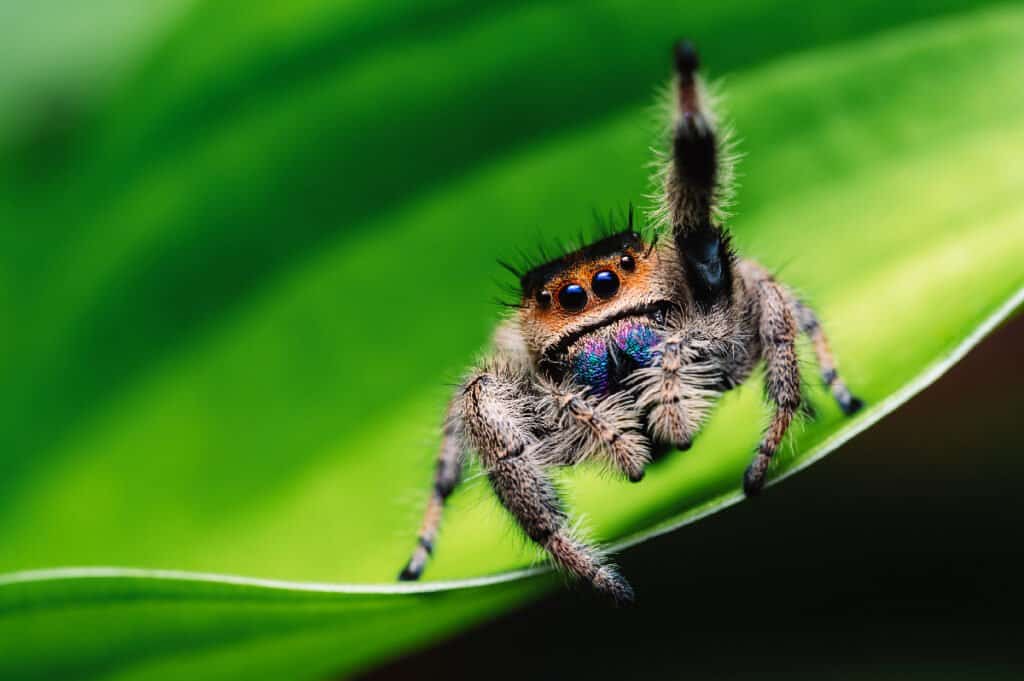
The emerald jumping spider possesses excellent eyesight and amazing leaping abilities.
©iStock.com/Jan Rozehnal
The emerald jumping spider is one of several jumping spiders found in Alabama. It belongs to the family Salticidae, which contains nearly 6,000 known species, the most of any spider family.
Female jumping spiders appear brown with orange markings, while males are black with white stripes down their sides. Both sexes feature metallic green coloring on their bodies and small white dots down their abdomens. Female emerald jumping spiders measure 8 to 12 millimeters in length and males are 7 to 10 millimeters long.
Emerald jumping spiders possess excellent eyesight and make long leaps to catch their prey. You can find them both in fields and indoors, as they often enter homes in search of food. While they can bite, they rarely do so, and their bite is not life-threatening to humans. More often than not, an emerald jumping spider will simply leap to safety if you get too close.
#2: Flower Crab Spider

Crab spiders often match the color of their surrounding flowers, including those that turn a beautiful shade of goldenrod.
©Tobias Hauke/Shutterstock.com
The flower crab spider is a rather uncommon species of crab spider that happens to make its home in Alabama. It gets its name partly from its crab-like appearance and also from the fact that it often walks sideways.
Unlike most spiders, flower crab spiders do not spin webs to catch their prey. Rather, they ambush their unsuspecting prey from a blind spot. In particular, they like to hide in flowers and attack any insects that come to feed on the flower’s nectar. To aid them in this, the females of the species can camouflage themselves by changing their color to match their surroundings.
Female flower crab spiders typically measure 9 to 11 millimeters long, while males measure 3 to 4 millimeters long. They usually appear white or yellow, depending on what type of flower they are resting on.
#1. Northern Yellow Sac Spider
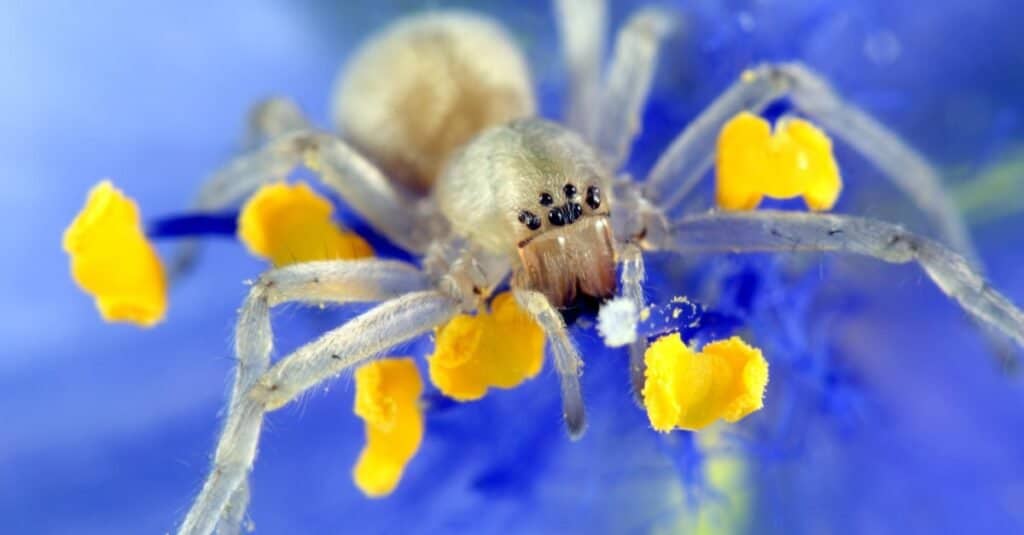
Northern yellow sac spiders create a silk sac for themselves rather than spinning a web.
©Brandon Alms/Shutterstock.com
The northern yellow sac spider is one of the more venomous spiders in Alabama. That said, while its bite is painful, it’s not as damaging as that of a brown recluse, which possesses similar necrotic venom. Typically, the worst symptoms are itchiness, slow healing, pain, and redness.
Northern yellow sac spiders usually appear tan or pale green rather than yellow. Most specimens measure between 7 to 10 millimeters long, and possess long legs that end in double claws.
Rather than spinning a web, a northern yellow sac spider creates a silk sac that acts as its shelter. You can frequently find their sacs located on leaves or in corners of your house near where two walls meet.
Summary of 10 Spiders in Alabama
Here’s a recap of the 10 spiders in the state of Alabama that we featured:
| Number | Spider | Length | Color |
|---|---|---|---|
| 1 | Northern Yellow Sac Spider | 7-10 mm | Tan or pale green |
| 2 | Flower Crab Spider | Females: 9-11 mm; Males: 3-4 mm | White or yellow, depending on what flower they are on |
| 3 | Emerald Jumping Spider | Females: 8-12 mm; males: 7-10 mm | Females: brown with orange markings; males: black with white stripes down their sides |
| 4 | Green Lynx Spider | Females are 12-22 mm; males are slightly smaller | Body is bright green with red markings and legs yellowish-green |
| 5 | Blacktailed Red Sheetweaver | 3-4 mm; females are slightly larger | Bright red |
| 6 | Carolina Wolf Spider | Females: 22-35 mm; males: 18-20 mm | Light brown color with darker brown markings |
| 7 | Brown Widow | Females: 7-10 mm, males: 2-4 mm | Brown and tan coloration with black markings |
| 8 | Woodlouse Spider | Females: 11-15 mm; males: 9-10 mm | Bodies and legs are orangish-red; abdomen is a yellowish-brow |
| 9 | Giant Lichen Orb Weaver | 24 mm | Orange legs with black rings and a greyish-green body with black and white markings |
| 10 | Neil Young’s Trapdoor Spider | 24-40 mm | Light to dark brown, with orangish-brown legs |
The photo featured at the top of this post is © iStock.com/CathyKeifer
Thank you for reading! Have some feedback for us? Contact the AZ Animals editorial team.






